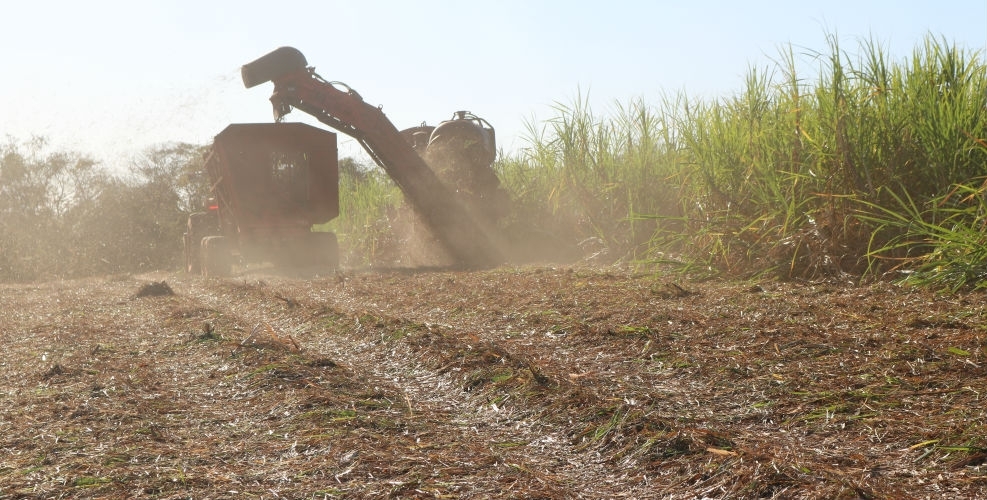


Brazilian researchers calculated the amount of nutrients in sugarcane leaves, which are normally left on the ground after harvest, and the equivalent in fertilizer required to maintain crop yield if the straw is removed (photo: Maurício Cherubin)
Published on 05/12/2021
By Maria Fernanda Ziegler | Agência FAPESP – The use of sugarcane leaves, known as trash or straw, to produce electricity and second-generation (2G) ethanol has been advocated as a means of increasing bioenergy generation without expanding cropland acreage. However, a study conducted in Brazil and published in the journal BioEnergy Research shows that removing straw instead of leaving it on the ground after the harvest could double the amount of fertilizer required by Brazilian sugarcane plantations by 2050.
The warning comes from researchers affiliated with the University of São Paulo’s Luiz de Queiroz College of Agriculture (ESALQ-USP) and the National Biorenewables Laboratory (LNBR) at the National Energy and Materials Research Center (CNPEM) in Campinas, São Paulo State, who carried out the study with support from FAPESP and the Technological Fund (FUNTEC) managed by BNDES, the national development bank.
Sugarcane harvesters cut the stalks at the base, strip off the leaves and chop the stalks into segments. The stalks are taken away for processing to make sugar and ethanol. The leaves are ejected and left on the ground, eventually drying out to form a thick layer of straw. This biomass is rich in nutrients and contributes to soil fertilization, the authors of the study stress.
For the first time, they calculated the amount of nutrients retained by sugarcane straw and the amount of fertilizer that would be required without the straw layer.
“In the study, we converted the value of the nutrients in straw into fertilizer equivalent [nitrogen, phosphorus and potassium, NPK]. Growers who remove this biomass will have to buy NPK and use it to replenish soil nutrients. We measured this value, which was hitherto invisible,” Maurício Cherubin, a researcher at ESALQ and first author of the article, told Agência FAPESP.
Keeping the straw on the ground helps nutrient cycling. Soil nutrients are absorbed and stored in the leaves, and the nutrients are returned to the soil when the leaves die and decompose, which ensures that a new cycle can begin. Removing the straw interrupts this process.
“Generating bioenergy by burning straw means using a third of the energy potential of sugarcane, which is a lot,” Cherubin said. “On the other hand, as the study shows, it’s important to leave a substantial proportion of the straw on the ground to protect the soil from rain, reduce greenhouse gas emissions and above all maintain nutrient cycling.”
Soil nutrition
Previous articles published in BioEnergy Research by the same group of researchers presented data on the effects of straw removal, such as diminished biological activity in the soil, less efficient pest control, more intense soil compaction, rising greenhouse gas emissions and lower crop yields.
“The purpose of our research has been to undertake a comprehensive review of the issues relating to straw removal. Some growers have realized the importance of straw for productivity because it influences soil protection and nutrition,” Cherubin said.
The most recent article reports the results of field studies performed to measure soil nutrient loss, the findings from economic analysis, and projections of scenarios based on fertilizer use data for west-central, southeast and south Brazil from the National Fertilizer Association (ANDA). Five possible scenarios are discussed. Strategies with less negative impacts keep green leaves and remove dry leaves, while the most extreme scenario assumes total straw removal.
Definition of criteria
According to the article, total straw removal results in an annual fertilizer requirement of 195 kg per hectare (kg/ha), which costs approximately USD 90. This is double the amount of fertilizer currently used in the above three regions, where most of Brazil’s sugarcane is grown.
The least radical scenario, assuming only moderate removal of dry straw with green leaves left on the ground, results in a fertilizer requirement of 27 kg/ha that costs USD 27.
“As can be seen, the decision whether or not to leave straw on the ground has a significant impact on the crop and the entire industry. Today, each mill uses its own criteria to define how much to leave and where. We need to move on. We need a collective effort to define criteria for this practice, with all the associated benefits in terms of bioenergy production, soil quality and productivity,” Cherubin said.
Brazil has some 10 million hectares of land under sugarcane and accounts for approximately 40% of world production. Most of the sugarcane (92%) is grown in five states – Paraná in the south, São Paulo and Minas Gerais in the southeast, and Goiás and Mato Grosso do Sul in west-central Brazil.
The study does not compare fertilizer costs with the prices of bioenergy generated from sugarcane straw. The value of a kilowatt-hour per hectare varies with demand, location, time of year and climate (wet versus dry season).
Growing use of fertilizer
According to the study, if the acreage under sugarcane continues to expand as it has for the past three decades, the consumption of NPK fertilizer by sugarcane growers will increase 80% by 2050. NPK fertilizer use increased by 46,500 metric tons per year between 1986 and 2016, when it reached 1.75 million mt, or 11.6% of all NPK fertilizer consumed in Brazil.
“The use of sugarcane straw for bioenergy is a great opportunity, but there are pros and cons. It enhances productive efficiency in a given area. On the other hand, as the study shows, it’s important to leave part of the straw on the ground,” Cherubin said.
The article “Sugarcane straw removal: implications for soil fertility and fertilizer demand in Brazil” (doi: 10.1007/s12155-019-10021-w) by Maurício R. Cherubin, Izaias P. Lisboa, Aijânio G. B. Silva, Letícia L. Varanda, Ricardo O. Bordonal, João L. N. Carvalho, Rafael Otto, Paulo S. Pavinato, Amin Soltangheisi and Carlos E. P. Cerri can be retrieved from: link.springer.com/article/10.1007/s12155-019-10021-w.
Source: https://agencia.fapesp.br/31795